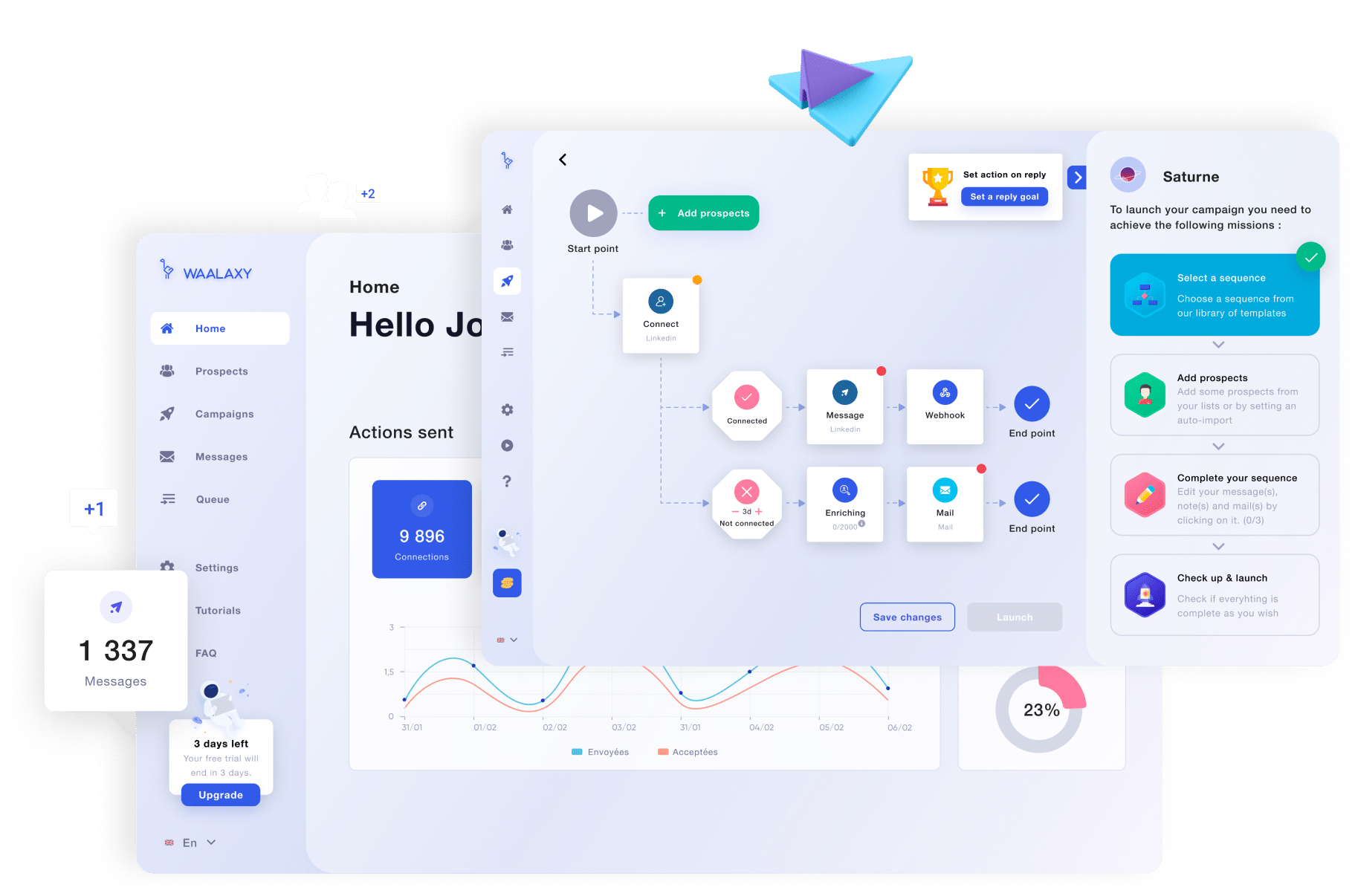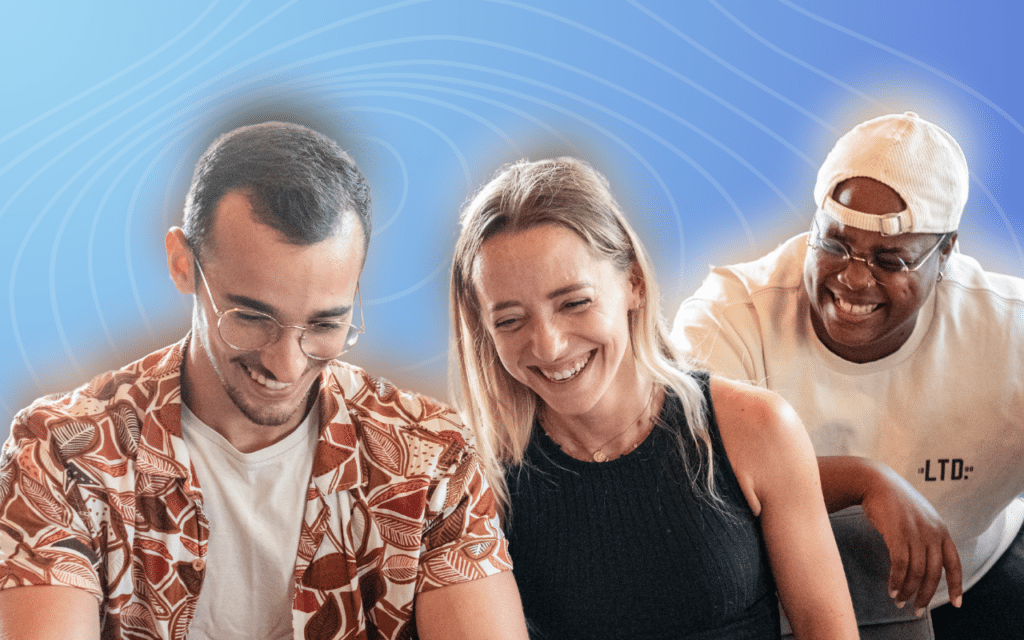By the way, do you really know what does 1st 2nd and 3rd mean on LinkedIn? 🔍 Did you think that LinkedIn company was just a public place for people to see your resume? You’re wrong…
Waiting for opportunities to come to you without being active on this professional social network is the worst idea ever!
You’d better think about growing a healthy social-networking: send and accept invitations carefully.
Building a relevant networking starts with understanding who are the other users on LinkedIn are and how to connect with your chosen ones, the ones that stand-out from the crowd. 🤗
Read this article and get to know the best tips to network efficiently. 👇
What does 1st 2nd and 3rd mean on LinkedIn?
Developing a healthy professional network requires some knowledge about the way LinkedIn level of contacts works.
For example, you must have noticed that you can always read a number next to a profile’s name. They are not here to give you a hint on how important the person is in their company! 🥸

On other networking sites, you can sort your “friends” out with your own filters. LinkedIn sorts out the people the same way we do in real life: family is supposedly the closest to you, then your friends, and finally the acquaintances. 🤗
What is LinkedIn 1st 2nd 3rd meaning?
On the social media platform LinkedIn, the 1st, 2nd and 3rd connections are the basic type of connection that have the contact information you know personally and/or trust on a professional level.
Once you connect with them on LinkedIn, you are considered a 1st level relationship. 🥇 Additionally, people who are connections of people in your network are considered 2nd level, and finally, if you have no connections in common, that person will be considered 3rd degree or higher. 🥵
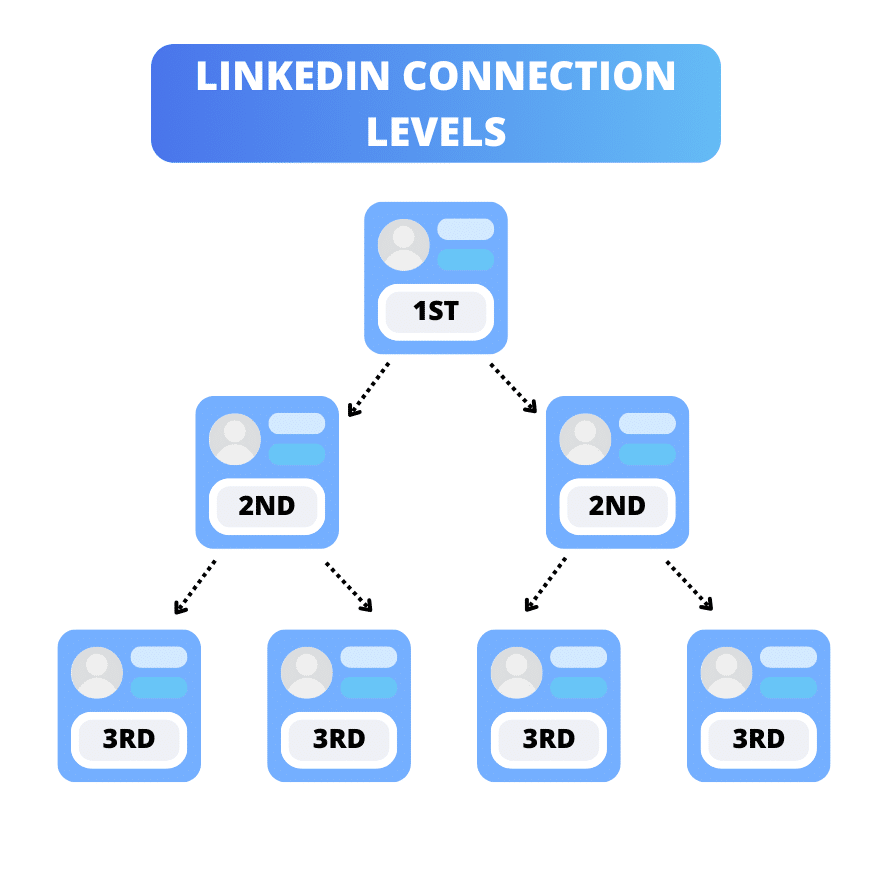
Here’s a quick recap of LinkedIn connection levels: ⏬
- 1st-degree connection: you are directly connected to this person, and do lead gen via LinkedIn. To do so, you have accepted or sent an invitation to connect that has been accepted. You belong to each other’s social networks. By this connection, you can communicate through LinkedIn messaging and see their news in your feed.
- 2nd-degree connection: these people do not belong directly to your professional network. They are “friends of friends”. Your 1st-degree connections are directly connected to them. You can send them an InMail if you subscribed to Premium, but can’t send them LinkedIn messages to their inbox otherwise. However, you’d still like to connect to them, so they become 1st-degree connections.
- 3rd-degree connection or 3rd and +: these people are 2nd-degree contact’s connections. That means that you have fewer chances to get to know them directly. You can still send messages via InMails, though.
Despite this social distance, is it still possible to connect with the 3rd level? Do you even need to? Does it sound relevant to try to connect regardless of the level of LinkedIn connections?
Keep on reading to get answers. 👇
LinkedIn Connections Explained: What Are Connection Levels On LinkedIn?
On LinkedIn, your #1 priority should be to take care and strengthen your 1st-degree connection, and then to explore a bit further to see which of your 2nd-degree connections could get you more opportunities.
What about 3rd-degree connections? Are they really too far from us to try to reach out to them? 🙈
To highlight this, we can identify 2 types of 3rd-degree connections: 👇
- They simply don’t belong to anyone’s network around you. Your 1st-degree contacts nor your 2nd-degree friends know them. In this case, you will see them as “LinkedIn members”. You may have a few hints on their job title, but not much more. Reaching out to them via email message is not permitted unless you can afford to send InMails.
- They can be part of your 2nd-degree contacts’ connections. Here is a nice tip to know if you can connect with them: if you see their complete surname on their LinkedIn profile, go for it, send your invites right away (if a salesperson looks professionally interesting, for example). If you can just see the first letter of their surname, you can try sending an InMail, but you won’t be able to connect directly.
Now let’s dive deeper into the different levels of connection on LinkedIn! 🤿
What Does 1st-Degree Connection Mean On LinkedIn?
Ah, the famous 1st-degree connection on LinkedIn—a title so coveted it should come with a crown! 👑 When you see that shiny label next to their name, you can practically hear the trumpets playing.
These fine folks have accepted your invitation and are now part of your LinkedIn network. 👍 You can easily send them a direct message, unlike those poor 3rd degree connections who are left wondering why you haven’t sent them a connection request yet. 🥹
For those looking to expand their network, LinkedIn’s Sales Navigator is your trusty sidekick. 😏 Why settle for just a name in search results when you can engage with your first-degree connections and peek into their profiles?
What Does 2nd-Degree Connection Mean On LinkedIn?
So, you’re diving into the world of LinkedIn and wondering what that 2nd-degree connection means? Well, let’s unravel this mystery! 🔮 If someone is a 2nd-degree connection, it means they’re just a hop, skip, and a jump away from your 1st-degree connections.
They’re connected to your 1st connection on LinkedIn, making them part of your immediate network. 🔗 It’s like “knowing someone who knows someone”—perfect for making that all-important introduction!
Now, if you find their name in the search results, you can send them a message or, if you’re feeling bold, try sending connection requests. 😉
What Does 3rd-Degree Connection Mean On LinkedIn?
Oh, you’ve stumbled upon the mysterious world of 3rd-degree connections on LinkedIn—the elusive folks who are just a hop, skip, and a jump away from your 2nd-degree connection on LinkedIn. 👀
Think of them as the “friends of your friends”. If you see a delightful little number 3 next to their name, rejoice! 🥉 They’re part of your expanding LinkedIn network.
But beware; you can’t just land into their DMs without first sending a connection request—unless you’re one of those fancy LinkedIn recruiters using premium to bypass the usual etiquette. 🙊
When you’re sending a message on LinkedIn, it’s like throwing a digital paper airplane—let’s just hope it lands in their inbox and not in the dreaded “I’ll get to it later” pile. 🛩️
To recap: LinkedIn uses a degree system to keep things cozy, so remember: 1st connections are your friends, 2nd-degree connections are their friends, and 3rd-degree connections are the friends of those friends… 🌬️
If you want to find people on LinkedIn, just type their name in the search results and see how many degrees of separation you really have. 😯 Who knew networking could be so complex?
What Are “Out Of Network” Users?
And last but not least, the “Out of network” users on LinkedIn! 🤫 These are the profiles who haven’t quite made it into your LinkedIn network, sitting comfortably far beyond the shadowy corners of 3rd-degree connections on LinkedIn….
They’re not connected to any of your 1st, 2nd or 3rd-degree connections, or they haven’t accepted your invitation—how rude! 😑
But fear not because with the savvy LinkedIn Sales Navigator, you can visit their profile and charm your way into their connections. ✨
Just remember, while you’re busy sending invitations and trying to connect with your 1rst-degree connections, there’s a delightful world of people on LinkedIn waiting to be discovered, 🧭 (if only they’d stop hiding their profiles)!
How To Go Beyond Your 1st-Degree Network?
Generally speaking, going beyond your 1st-Degree connections means getting out of our comfort zone and exploring unknown fields. 🔍 Following this logic on LinkedIn pushes you to first send a connection request to 3rd-degree connections to grow your professional network.
Don’t fall in that trap! It sounds tempting, but we have a better solution for you. ⚡
We wouldn’t recommend this strategy to prospect on LinkedIn. Of course, if you notice a particularly intriguing 3rd-degree connection you can invite, do it. 💪 However, we’d rather advise you to strengthen first your 1st and 2nd-degree connections’ relationship before thinking of growing your network…
Even if you can balance different moves according to your B2b prospecting plan! 🔔
LinkedIn 1st 2nd 3rd meaning is to encourage you to actually know your contacts before looking out for new friends! If you are really eager to expand your network, invite your 2nd-degree contacts to connect and get in your direct network.
They will become 1st-degree connections, and guess what? Their 1st-degree contacts will become your 2nd-degree connections… It will get easier to contact them in the future! 🤝
Why should you add Connections outside your Network?
Adding connections outside your network brings many benefits. And to do so, you could think of an automation software, like Waalaxy 👽 to add more and more contacts!
Furthermore, our goal is to automatize the most time-consuming tasks to allow you to actually bond with your prospects.
For example, start by browsing our selection of automated scenarios. Also, keep in mind that you can send automated friendly messages through our software, and much more. 🚀
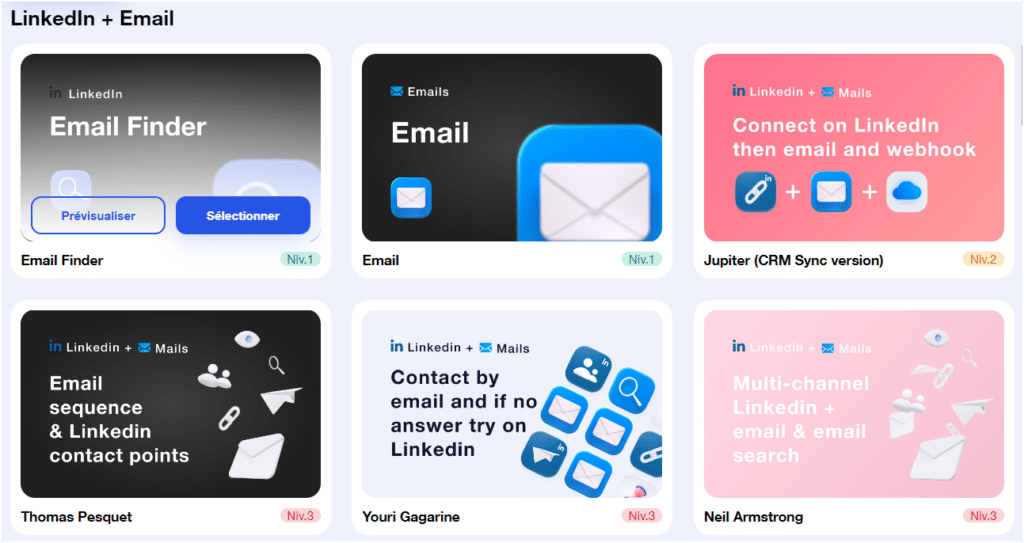
Try this: use a simple campaign on your 2nd-degree connections to open unsuspected doors! 🚪 Visit their social media profile page, they might be curious enough to visit you in return and maybe send you an invitation…
If you add a connection, you would enter their network as a 1st-degree connection and be closer to your previous 3rd-degree connections. All these people could become potential customers and interesting prospects, couldn’t they? 🧲
How to create your efficient prospection campaign on your 2nd-degree contacts? 🤔 First, try to search results by filters to see who are your 2nd-degree connections.

Then proceed to click on Waalaxy icon on your Chrome browser, choose how many profiles you’d like to add to your target audience, and, back on Waalaxy CRM interface, you can set up campaigns: or you can visit them or invite them straight away. 💥
However, your best option would be to include them all in a scenario. Start by paying a visit to their profile, wait a few days before inviting them, and welcome them with a friendly and personalized message. 😁
At the end of the scenario, the people who didn’t react to any of your messages will get out of your scenario so that you can focus on those fresh new prospects! 🎣
Conclusion: LinkedIn Level of Contacts
Ah, the world of LinkedIn! 🌏 It’s a delightful jungle where 1st-degree connections roam freely, while the elusive 2nd and 3rd degree connections lurk in the shadows, waiting for their chance to shine.
You know, you can spot a 2nd degree connection by that charming little degree icon next to their name—it’s like a secret badge of honor! 🥈 If you’re feeling adventurous, why not send them a connection request? After all, they might just be a mutual connection away from becoming your next direct connection.
And let’s not forget the wonders of LinkedIn groups; they’re the perfect playground for expanding your network. 💥 Just be careful not to dive too deep into the rabbit hole of 3rd degree connections—you might find yourself lost in the maze of 2nd and 3rd-degree connections! 🐇
But wait, there’s more! If you’re feeling particularly bold, why not use LinkedIn to send a direct message to one of those intriguing 3rd degree connections? Just imagine the thrill of networking like a pro! 😎
And while LinkedIn doesn’t come with a magic wand, 🪄 it does offer LinkedIn InMail for those who dare to reach out to someone outside their immediate circle.
Just think, you could be one direct connection away from your next big opportunity, 👏 all thanks to those cleverly orchestrated degree connections on LinkedIn. So, dust off that profile, polish your pitch, and let the networking games begin! 🏹
FAQ of the article
What is the difference between 1st, 2nd, and 3rd LinkedIn?
The difference between 1st, 2nd and 3rd-Degree on LinkedIn, is that a connection is a contact to whom you have a 1st degree connection. 🤝
You can connect with someone from your 2nd-Degree by accepting an invitation from them, or when they accept an invitation you sent. 📨 While 3rd-Degree connections are visible on your LinkedIn contact list, not all contacts are 1st degree connections.
If you don’t know someone’s personal information like their email address or phone number, and you weren’t a colleague or classmate in the past, then you can contact new members on LinkedIn by using an InMail (or not 🤫) to find new connections.
Can you connect with 3rd Connections on LinkedIn?
It depends… when you see the “LinkedIn Member (Out of Network)” pop-up – it means the LinkedIn members who fall outside the categories listed above or beyond the 3rd-Degree Connections cannot be contacted. This means you don’t have access to their profile: 👇
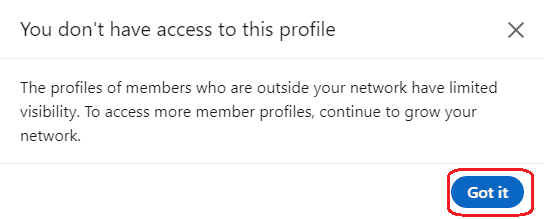
Some profiles out of your network have limited visibility depending on their Privacy Settings, but you can build your network with other valuable connections to see more social profile.
If the option is available, you can also send them a connection message to introduce yourself. 😉
What do the numbers next to names on LinkedIn mean?
Ever wondered what those numbers next to names on LinkedIn mean? 🤔 They’re like a social hierarchy, indicating your degree of connection. If you spot a 2nd degree icon next to someone’s name, congratulations! You’re just a connection away from someone in your 1st-degree network.
Now, if you see a 3rd degree icon next to a name—these are users who are practically strangers but share a distant relative in the LinkedIn family tree. 🌳
While you’re busy doing LinkedIn prospecting, remember that LinkedIn imposes a limit on connection requests. ⏰ So, connect carefully, or you might end up in the digital equivalent of the friend zone!
How to get 500+ LinkedIn connections fast?
Looking to boost your number of LinkedIn connections faster than you can say “networking ninja”? 🥷 Start by sending connection invites to 2nd-degree connections—they’re just waiting for your request. But remember to personalize your message; no one wants a generic “Let’s connect!” from a robot. 🤖
Once they accept, don’t just keep the connection but also interact with them! 🗣️ For example, join LinkedIn events and mingle with 3rd-degree connections—who knows, some might become your next business partners.
And don’t forget the magic of LinkedIn automation—A tool like Waalaxy can help you reach out to new connections while you sip coffee! 🍵 Just be careful, you don’t want to send too many connection requests too fast.
There you have it, now you know what does 1st 2nd and 3rd mean on LinkedIn! 🤗

